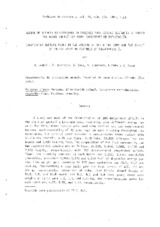Mostrar el registro sencillo del ítem
Harina de alfalfa deshidratada en raciones para cerdas gestantes y efecto del nivel energético sobre caracteres de explotación
| dc.contributor.author | Aparicio Ruiz, F. | es_ES |
| dc.contributor.author | Peña Blanco, Francisco | es_ES |
| dc.contributor.author | Tovar Andrada, J.J. | es_ES |
| dc.contributor.author | Vera y Vega, A. | es_ES |
| dc.contributor.author | Domenech García, V. | es_ES |
| dc.contributor.author | Jodral Gutiérrez, A. | es_ES |
| dc.date.accessioned | 2010-05-10T10:13:20Z | |
| dc.date.available | 2010-05-10T10:13:20Z | |
| dc.date.issued | 1987 | |
| dc.identifier.issn | 1885-4494 | |
| dc.identifier.uri | http://hdl.handle.net/10396/3221 | |
| dc.description.abstract | A study was made of the incorporation of 20% dehydrated alfalfa in the diets of gestating Landrace sows, comparing also different energy levels. For this, three batches were used —one control and two experimental batches, each consisting of 10 sows kept in open stabling throughout the experiment. The control batch consumed a concentrate— based ration with 14.75% raw protein, 4.5% raw fibre, 2.5% fats, 58.83% nitrogen—free extracts and 3,087 Kcal/Kg feed. The composition of the feed consumed by the two experimental batches was as follows: 14.93%, 8.85%, 2.54%, 57.13% and 2,830,Kcal/Kg, respectively, with 20% incorporated dehydrated alfalfa flour. The quantity consumed by each batch was 2,250; 2,450; and "1,855 g/head/day, providing 6,946; 6,933 and 5,250 Kcal of digestive energy per sow. Live weight gain covering to 112 days gestation was 45.5, 41.2 and 38.5 Kg, representing a mean daily gain for that period of 406, 371 and 344 g, respectively. Comparison of total live births showed totals of 10.5, 9.9, and 10.0 young, and 9.8, 9.6 and 9.8 live young whose mean weights at birth were 1.2, 1.3, and 1.14 Kg. The transformation index for each batch was 4.58, 5.95, and 4.87, respectively. | en |
| dc.description.abstract | Se estudia la incorporación de un 20% de alfalfa deshidratada en dietas, para cerdas de raza Landrace en gestación, comparando al mismo tiempo niveles energéticos diferentes. Empleamos tres lotes: uno testigo y dos experimentales, de 10 cerdas cada uno, que se mantienen en semiestabulación durante, toda la experiencia. El lote testigo consumió una ración a base de concentrados con un 14"75% de proteína bruta, 4"5% de fibra bruta, 2"5% de grasa, 58"83% de S.E.L.N. y 3.087 Kcal/kg de pienso. La ración ingerida por los testigos lleva 14"93%, 8"85, 2"54, 57"13% y 2.830 Kcal/kg, respectivamente, y un 20% de harina de alfalfa deshidratada. Las cantidades ingeridas por cada lote fueron 2.250, 2.450 y 1.855 g/cabeza/día, lo que les proporcionó 6.946, 6.933 y 5.250 Kcal de E.D. por cerda. Los incrementos en peso vivo, desde la cubrición hasta 112 días de gestación, fueron 45"5, 41"2 y 38"5 kg; lo que supone una ganancia media diaria, para el período citado, de 406"371 y 344 g, respectivamente. Al comparar el número de lechones nacidos, total y vivos, los resultados encontrados fueron de 10"5, 9"9 y 10"0 lechones; y de 9"8, 9"6 y 9"8, para los nacidos vivos, que alcanzan, en media, un peso, al nacer, de 1"2, 1"3 y 1"14 kg. El índice de transformación, para cada lote, es de 4"58, 5"95 y 4"87, respectivamente. | es_ES |
| dc.format.mimetype | application/pdf | es_ES |
| dc.language.iso | spa | es_ES |
| dc.publisher | Universidad de Córdoba, Servicio de Publicaciones | es_ES |
| dc.rights | https://creativecommons.org/licenses/by-nc-nd/4.0/ | es_ES |
| dc.source | Archivos de zootecnia 36 (134), 23-36 (1987) | es_ES |
| dc.subject | Porcino | es_ES |
| dc.subject | Alimentación animal | es_ES |
| dc.subject | Cerdas gestantes | es_ES |
| dc.subject | Caracteres reproductivos | es_ES |
| dc.title | Harina de alfalfa deshidratada en raciones para cerdas gestantes y efecto del nivel energético sobre caracteres de explotación | es_ES |
| dc.title.alternative | Dehydrated alfalfa flour in the rations of gestating sows and the effect of energy value on features of pig—farming | en |
| dc.type | info:eu-repo/semantics/article | es_ES |
| dc.relation.publisherversion | http://www.uco.es/organiza/servicios/publica/az/az.htm | es_ES |
| dc.rights.accessRights | info:eu-repo/semantics/openAccess | es_ES |

